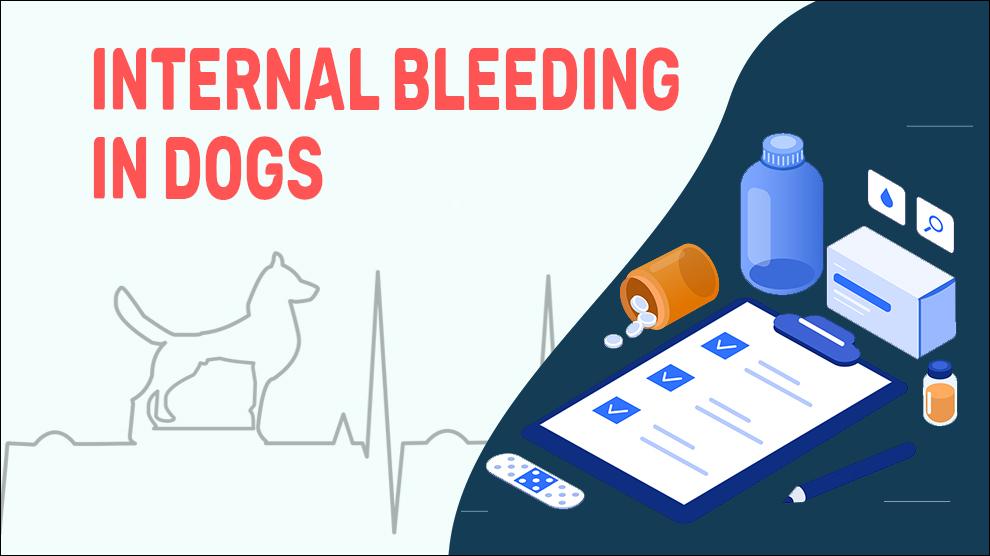As external bleeding is visible, it is often easier to deal with and your vet determines its severity and provides the right solution in a relatively clear-cut manner. However, internal injuries are difficult to spot and maybe even more serious.
Internal bleeding due to any trauma may stop on its own. However, tumors and malignant blood vessels are more prone to internal bleeding than normal vessels. Many pet owners have been shocked to see their dog die suddenly due to a condition known as hemangiosarcoma (which typically leads to high amounts of blood loss in the abdomen)
The signs of internal bleeding are often varied and misleading. When they go unchecked, dogs can bleed to death within a few minutes to hours.
Whenever you suspect that your dog has internal bleeding, make sure to rush your pet to the nearest emergency vet care!
Symptoms Of Internal Bleeding
There are some external signs of internal bleeding, which can include:
- Early signs include shallow breathing and rapid heartbeat
- General Malaise/ Weakness
- Unusually subdued/Depression
- Black diarrhea
- Gum color change – pale or blue
- When touched or moved, the dog whimpers
- Bruising or scraping wounds
- Glazed eyes
- In coordination
- Coughing or vomiting up blood
- Heart attack
Treatment Options For Internal Bleeding
- Treatment options depend on the location of the bleeding. For example, in cases of broken bones, it makes sense to find the cause of the bleed and remove it surgically. On the other hand, bleeding in the brain, for instance, breaching the brain cavity for treatment may do more harm than good.
- The cause of bleeding is also important. For example, the pet doesn’t have the required clotting factors and internal bleeding occurs, then it would be a generalized bleeding (in different locations).
- The proper treatment would be a blood transfusion, with proper clotting factors.
- Certain medications:Certain medications, like blood thinners (used in heart, stroke treatment) may cause gastrointestinal bleeding if the pet is injured or have an accident. Some NSAIDs, such as ibuprofen and mefenamic acid, can damage the lining of your stomach.
- Trauma:Experiences including accidents, falling from heights, and dropping a heavy object on the dogs can damage the organs, bones, blood vessels etc. Dogs may experience internal bleeding without scratching of their skin.
Home Remedies For Internal Bleeding
Discuss with a veterinarian any home care specific to your dog’s situation
Check with your veterinarian for post-surgical checks, usually once a month to ensure the health of the dog and to check for any infection.
Supportive therapies can be done at home and can include topical medications, oral antihistamines, antibiotics, anti-clotting medications, and complementary treatments.
Prevention Of Internal Bleeding
- The first rule in prevention is when transporting an injured pet is to avoid injury to yourself.
- Take necessary precautions, restrain the injured dog and if it is conscious, let it decide the best position for travel.
- Minimize the movement- gently tie or tape the dog to a firm, flat support such as a piece of plywood or collapsed cardboard box.
- Use a muzzle, to prevent an agitated from barking or biting.
- You can create a “make-shift muzzle” by using any nylon webbing and thread or gauze or stretchy fabric such as a men’s tie or a non-retractable leash.
- Enroll yourself in a pet first aid class and this is the best way to learn these techniques.
- Local chapters of the Red Cross, humane organizations, and some shelters offer pet, first aid classes, on a regular basis
Affected Breeds Of Internal Bleeding
There is no breed predisposition. Older breeds are overrepresented.
Additional Facts For Internal Bleeding
Causes:
- Cancer
- Injury
- blood-thinning or anti-clotting medications
- gastrointestinal conditions
- liver, kidney, or spleen conditions
- Injection of Poison
- Trauma
- Laceration
- Abuse by humans
Diagnosis:
- complete blood count (CBC),
- Abdominal ultrasound/x-rays
- Multiple blood tests
- computed tomography (CT), or magnetic resonance imaging (MRI)
- electrocardiogram (EKG)
- serum chemistry profile
Prognosis:
This depends on the dog’s conditions, but there are two things to consider.
- The first is the possibility of their surviving surgery or any treatment in the short term
- The second is the long-term result. For e.g., if a hemoabdomen or bleeding tumor in the spleen has already spread, the vets suggest surgery as it might help the animal to survive initially but owners may not want to operate…. This is a conversation between the vet and the owner.
When To See A Vet
Pet owners should be aware of the internal bleeding symptoms. If you have reason to believe that the pet is susceptible to internal bleeding and notice any of the symptoms in your pet, take your pet to the nearest emergency veterinary center.
Food Suggestions For Internal Bleeding
- Dog food high in iron: 1 mg of iron / every 12 grams of the food.
- Cooked liver: 2 ounces for a smaller dog, 4 ounces for a large dog;
- Lean meats like lamb, ground beef
- Beef balls/beef stew
- Salmon, Tuna, Sardine
- Vitamin C: 500 to 2,000 milligrams (Vit C helps the body absorb iron from the intestinal tract) per day.
- Vitamin B: Rice flour, Oats, Sweet potatoes, Banana, Watermelon, Lamb brain, Mackerel, etc
- Green vegetables and leafy produce: Beets, Carrots, Kale, Seaweed, Spinach
- Grains: Oatmeal, Barley, Brown rice
Conclusion
The prognosis is good for dogs that is diagnosed and treated early for internal bleeding. The prognosis decreases if dogs lose 40% of their blood volume from trauma. The most important thing is to receive treatment as soon as possible.

















